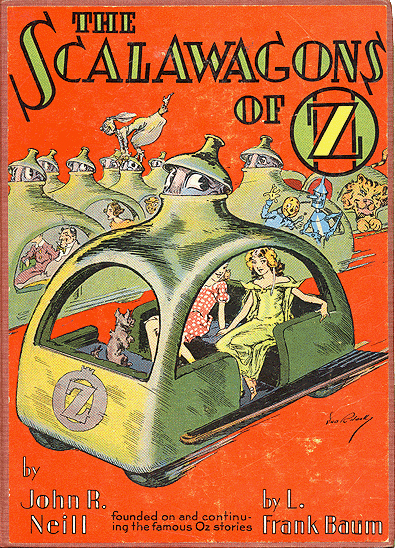For years, I heard legends of an Oz book so terrible, even diehard Oz fans had trouble finishing it; so terrible, that other authors rushed to pick up pens and typewriters in a desperate attempt to save Oz. Not surprisingly, it was terribly difficult to find. None of my many childhood libraries had it. Interlibrary loans didn’t have it. Research libraries didn’t have it. And yet, its legend persisted: it would, I was warned darkly, wipe my mind.
Naturally I had to track it down.
And now I have read it, and I have to tell you, good, it isn’t.
Its title: The Scalawagons of Oz.
The chief problem with The Scalawagons of Oz is that the book doesn’t really have a plot. Or, rather, it sort of has one, but most of the time, no one, and I include author, characters, and readers in this, can be bothered to remember what it is, or care much what it is. The plot sort of has to do with a little Bell-Snickle, who for inexplicable reasons likes to do mischievous things and be mysterious. And it sort of has to do with the Scalawagons: magical cars invented by the Wizard of Oz that can think, if we stretch the definition of “think,” speed along to any destination without crashing, and provide excellent lunches. Yum. In the only real connection between the two plots, the Bell-Snickle sets off something that makes the Scalawagons disappear, but, to be honest, I’d completely forgotten this by the time the Bell-Snickle reappeared after an absence of several chapters.
Which leads to the book’s other problem: none of it lingers in the memory for more than a few minutes. Much of the potentially memorable stuff—the partially sentient houses with their tendency to attack, the rather mean and untruthful clocks—were already seen in the previous book, and feel rather tired, if somewhat more coherent.
Pacing is another problem. The Wizard and his magic cars disappear in the first half of the book, and, well, no one really cares much, and then they reappear about midway through, and then everyone goes swimming, and then, Neill suddenly seems to remember that he really does need to fill an entire book, so everyone gets into the little magic cars to fill up some more chapters, and things sort of happen, none of them particularly interesting, let alone suspenseful. And, given that none of the characters seem to take the “threat” of the Bell-Snickle seriously, it’s hard for a reader to get involved.
The only somewhat unifying element: the themes of work and time. Neill’s earlier concept of dishonest, disobedient clocks has been expanded to include a bad tempered clock who dislikes unpunctual people. (I can’t help wondering if Neill is projecting a little here.) And although a significant part of the nonexistent plot involves going on a trip to a magical bathing spa (complete with singing swimming suits) and enjoying a lot of picnics and lazily traveling by magical cars that do your driving for you, a significant number of words are devoted to the concept that everyone, even bell fairies and mysterious Bell-Snickles must work. It is, to say the least, a rather mixed message, further undercut when a little Misfit, who has been working far harder than anyone else, is exiled from Oz for…being an annoying workaholic. So much for the unifying theme and moral message.
I also don’t get why Ozma thinks it’s a great idea to send walking trees out to fight dragon-induced forest fires (this is less interesting than I just made it sound) but it is becoming clear that I may never understand just why Ozma remains in power.
Oddly, despite these flaws, Scalawagons actually reads a bit better than The Wonder City of Oz—the sentences are less choppy, the book is less inconsistent, and it’s sort of entertaining to realize that you can be living in the most wondrous palace in the most marvelous fairyland in the world and still want to escape on a little swimming trip, even if you have to wear a singing swimming suit. And the book has some bits of awesomeness, expected and unexpected: the illustrations. The sudden appearance of capital letters to tell us “BUT THE WIZARD HAD VANISHED,” followed by the realization that no one really seems to care or at least feels the need to bother to do anything about it. Aunt Em yelling at everyone. Getting rid of that pesky worker who keeps insisting on doing everything better and more intensely than you can. But, alas, none of these make the book terribly readable or memorable, and I can’t recommend it, even to Oz fans.
Also, this is a difficult book to track down for a reasonable cost just now. As I mentioned, it’s not readily available at most libraries. (My own local library, extremely helpful with other Oz books, including the somewhat hard to find Jack Snow books, failed here.) As far as I can tell it has not been recently reprinted, and since it’s still under copyright I think it’s unlikely to appear in a cheap digital edition any time soon. You may be able to find copies of the book on eBay or elsewhere, but, to be honest, if you want a better idea of Neill’s manic ideas, try Wonder City of Oz, and if you want a (somewhat) better Neill book, wait for the next in the series, Lucky Bucky in Oz.
Mari Ness would rather like a car that would just drive her around and provide cookies. She lives in central Florida.










